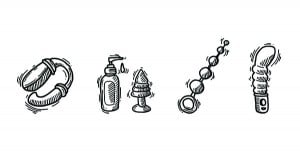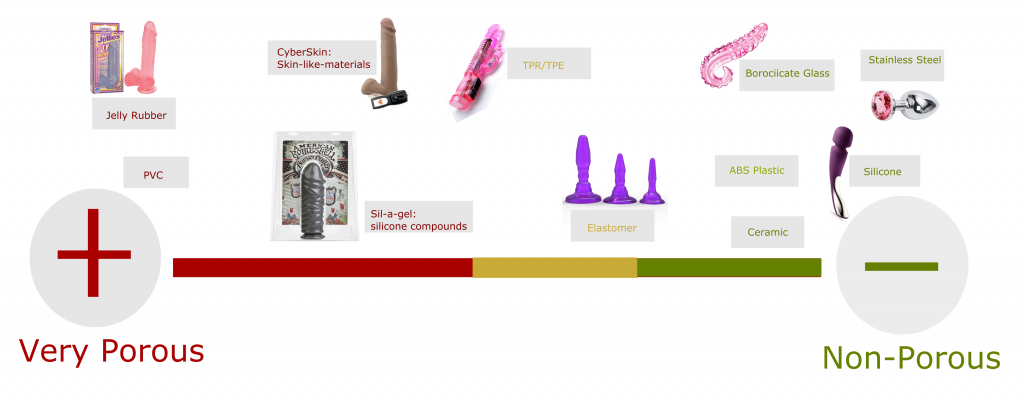 You have probably heard the phrase “You get what you pay for.” When it comes to sex toys this is especially true. It may be surprising to find out that the adult toy industry is currently completely unregulated. In fact some of the plastics used to make cheap dildos have been banned in many developed countries for use in household products and children’s toys. But because adult toys are considered novelties, they often do not fall under these bans, and no one can be held accountable if something goes wrong. This is an unfortunate reality that places the responsibility on consumers to look out for their own health.
You have probably heard the phrase “You get what you pay for.” When it comes to sex toys this is especially true. It may be surprising to find out that the adult toy industry is currently completely unregulated. In fact some of the plastics used to make cheap dildos have been banned in many developed countries for use in household products and children’s toys. But because adult toys are considered novelties, they often do not fall under these bans, and no one can be held accountable if something goes wrong. This is an unfortunate reality that places the responsibility on consumers to look out for their own health.
The good news is that today’s push for sex positivity and body safety has given rise to many sex toy companies that only produce toys using body-safe materials. This leads us to ask: What are the criteria for an unsafe material, and how can you identify toys that are safe to use?
Conditions that create toxic toys: porosity and chemical composition
Chemical composition: Let’s explore for a bit not only the dangerous chemicals used in cheap sex toys, known as phthalates, but also the type of tissue that your vaginal wall is comprised of: the mucous membrane. Mucous membranes are sensitive, and phthalates are harsh. If the two mix, consequences can be painful.
Phthalates: According to the Consumer Product Safety Commission, 6 different types of phthalates have been banned from use in children’s toys since 2008. Phthalates are chemical plasticizers often (but not always) used to make plastics softer and more pliable. Phthalates have been known to cause itching, chemical burns, and permanent tissue damage. These are commonly misdiagnosed as STDs/STIs.
Mucous Membrane: You may have noticed that the tissue that makes up your vulva and vagina can be more sensitive than the rest of your skin. This is because it is actually made up of a mucous membrane, just like your mouth and nostrils. Vaginal care is very important; the PH balance is easily disrupted. Your vaginal canal can be very sensitive, and phthalates can, as stated before, give your vagina chemical burns. But any porous toy that you can’t fully clean has the potential to leave behind bacteria, which can then grow and cause infections.
Porosity: Every sex toy exists on a spectrum of porosity, ranging from very porous to nonporous. Essentially this means some materials are sponges for bacteria. The more porous it is, the more likely germs and bacteria can grow and thrive. Even if you are washing a toy after every use, you cannot fully sanitize it and you will never be certain of complete cleanliness. Less porous materials can be sanitized in more effective ways such as boiling.
Jelly Rubber: In the sex positive communities, jelly toys are the ultimate offender on the toxic toy registry. Jelly toys are made from a mix of PVC and rubber, and they have a large concentration of phthalates (see below) to make them soft and “skin-like.” Jelly toys are also incredibly cheap and are often bought as gag gifts or as first toys because they are easy to find. You can easily identify a jelly toy when you find a vibrator or dildo that is clear, sticky to the touch or has a chemical smell.
PVC: This is another porous plastic with a really bad rap sheet, and has been banned in some countries. PVC toys are typically hard, not soft and squishy. These toys can degrade with use. Imagine having a vaginal vibrator that begins pink and sparkly, then after several months of using it you discover that the sparkles are disappearing. This could never be argued as safe for use inside the vaginal canal. Same goes for the PVC butt plugs.
Elastomer: This is the “middle of the road” for skin-like squishy dildos. Elastomer is the answer to a jelly toy that is almost not toxic. While it is phthalate free, and therefore probably won’t give you any chemical burns, it is still porous, just not as porous as jelly rubber. These toys are usually in the same price range as jelly rubber and PVC, but are less likely to burn your vagina o.O
TPR/TPE: This phthalate-free, silicone compound plastic can be found in hard plastic and soft malleable forms. TPR is a safe alternative to PVC while still being relatively cheap. Many companies who advertise body safe toys and affordable prices tend to have a large selection of TPR/TPE toys.
Medical Grade Silicone(platinum-cure silicone): Silicone is the savior of the toy industry. It is hypo-allergenic, completely non-porous, and free of the dreaded phthalates. It can be boiled for full sanitation or even cleaned with a 10% bleach solution if necessary. If you are planning on using a toy for anal play, you are going to want one you can boil and fully sanitize before and after. Silicone is a very diverse material that can be used to make a wide range of different types of toys. It can also range in density, which some companies like Bad Dragon have taken advantage of, and actually give their customers a choice in how they want their dildo to feel. Silicone is not a cheap material and the prices of the toys reflect that, usually starting around $60 and increasing from there. But the price is worth having a toy that can last for years with proper care.

Ideally, as we continue to become an increasingly sex-positive nation, toxic toys will be eliminated altogether. For now, we must be cautious consumers and strive to educate others on these important safety issues.
So what do you, as the consumer, do with all this information? You must be vigilant about what you are putting near and in your vagina. The best way to do that is to educate yourself and others about this topic. Being able to recognize the materials your toys are made of is really important. Toxic toys are going to smell and feel different. they are also going to be cheaply made, and their price is going to reflect that. One thing to be aware of is that many companies will falsely label their toys “phthalate free”, which is just the reality of an unregulated industry.
A great way to avoid false advertising is to only buy toys from companies whose entire platform is body safety. Ideally, as we continue to become an increasingly sex-positive nation, toxic toys will be eliminated altogether. For now, we must be cautious consumers and strive to educate others on these important safety issues.
[Image Source: Adobe Stock]














